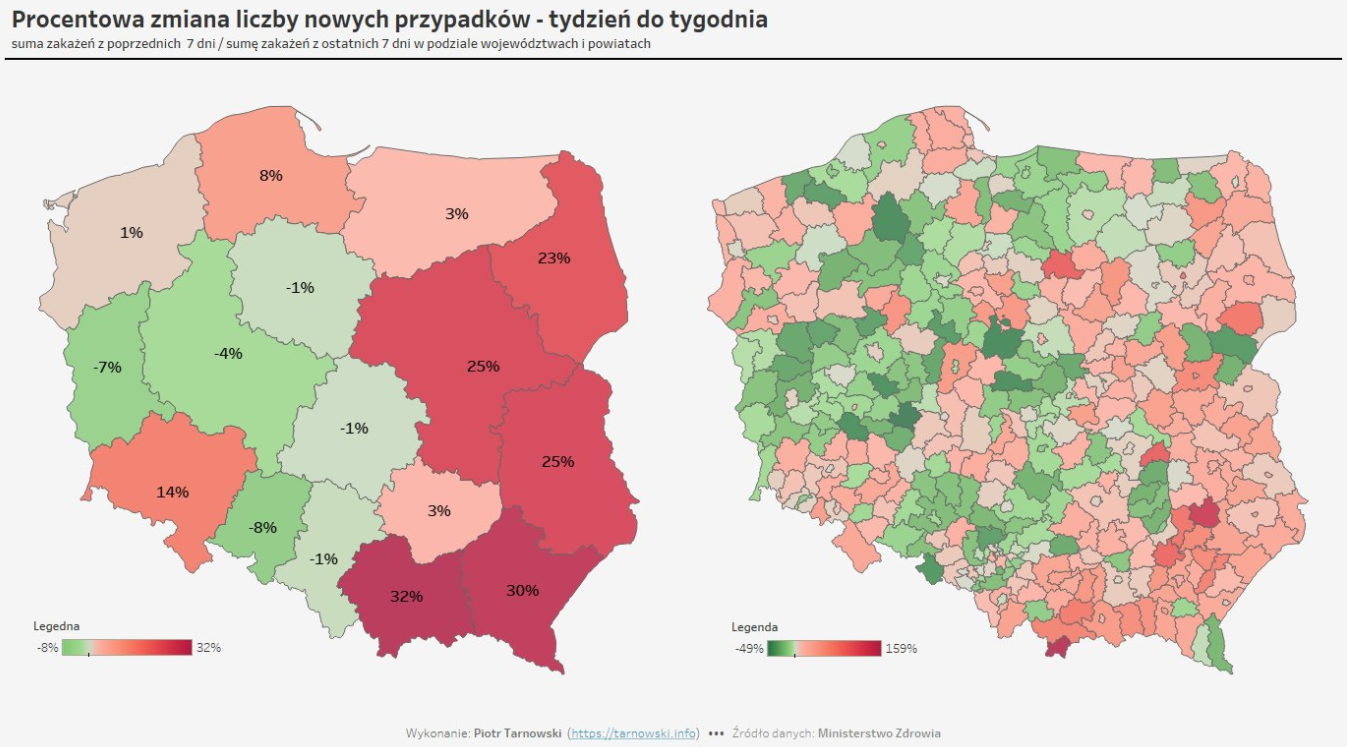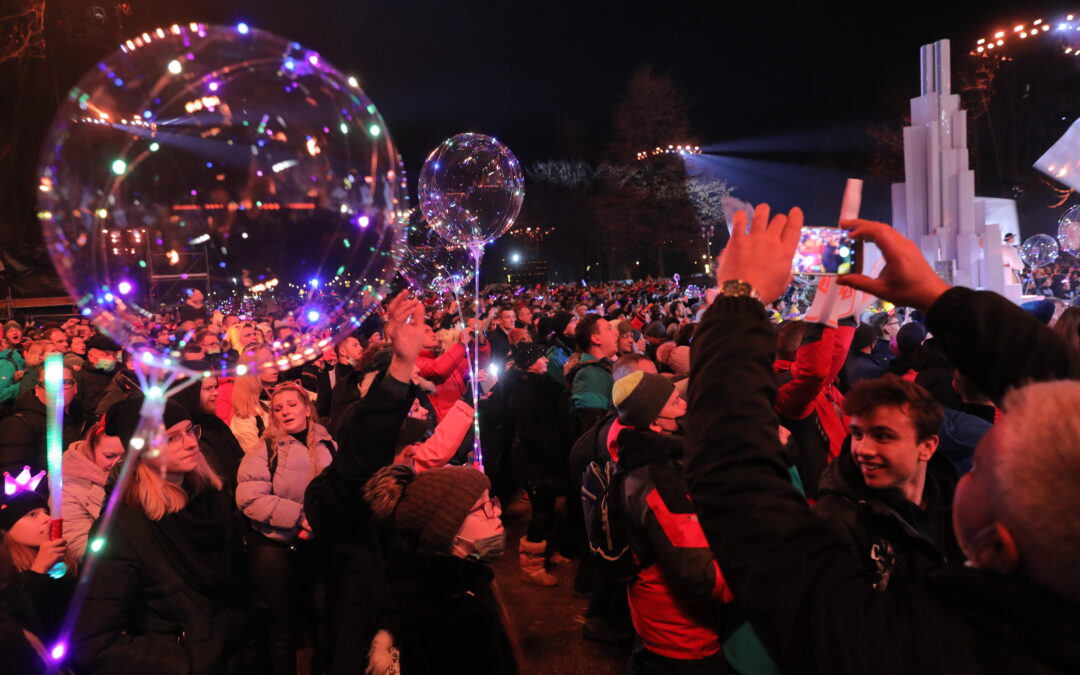The area around Zakopane, Poland’s “winter capital”, saw coronavirus infections jump by 160% in the space of a week after tens of thousands of people joined New Year’s Eve celebrations there, including a concert organised by state television that drew an audience of 30,000.
On 10 January, the rolling weekly average of new COVID-19 cases in Tatra county was 159% higher than a week early, according to health ministry figures. That was a bigger increase than in any of Poland’s other 379 counties, and 16 times higher than the 10% rise in infections across Poland as a whole over the same period.

Percentage change in the rolling weekly average of daily new COVID-19 cases between 3 and 10 January in each of Poland’s provinces (right) and counties (left). Tatra County is the darkest red area on the southern border. (Visualisation by Piotr Tarnowski based on health ministry data.)
Tatra county – located in the southern Tatra mountains on the border with Slovakia – is home to a large winter sports and tourism industry.
It has also become the host of state broadcaster TVP’s “New Year’s Eve of Dreams” (Sylwester Marzeń), an annual televised concert to ring in the new year. The star of this year’s show was American singer Jason Derulo, who featured alongside a host of Polish and international performers.
The event faced criticism for admitting a closely packed crowd of up to 30,000 people (some of whom are pictured above). A large proportion of them were not wearing masks, despite several appeals from the hosts for them to do so.
Among those pictured without a mask was Joanna Kurska – the wife of TVP’s president Jacek Kurski – and Joanna Lichocka, an MP from Poland’s ruling Law and Justice (PiS) party.
I Pan Jacek Kurski z małżonką się świetnie bawią 🥂 Maseczki połowicznie, ale co w rodzinie to nie zginie. pic.twitter.com/3vjiHscNn5
— Żaneta Gotowalska (@gotowalska) December 31, 2021
Afterwards, Jacek Kurski dismissed criticism of the event as part of “a plan to overthrow the government” by “fifth columnists” with foreign support. He noted that, in accordance with government regulations, all but 250 members of the crowd were fully vaccinated.
Lichocka also claimed that “there is no obligation to wear masks in the open air”, only in “closed spaces”, reports Wirtualne Media.
However, current Covid rules state that at outdoor concerts the audience must maintain distancing of 1.5 metres and “comply with orders to cover their nose and mouth”.
Byłam na #sylwestermarzeń, chciałam zobaczyć jak to wygląda z bliska… Otóż bardzo dobrze wygląda, świetna organizacja, świetna zabawa, gratki dla @KurskiPL 🙂 Aha, żeby tam być musiałam okazać paszport covidowy (tak, inni też musieli). Uprzedzono o tym grzecznie w zaproszeniu;) pic.twitter.com/P8LjHZyeex
— Joanna Lichocka (@JoannaLichocka) January 1, 2022
In addition to TVP’s concert, tens of thousands more partygoers descended on Zakopane to celebrate New Year’s Eve. Nightclubs and discos were closed by the government on 15 December, but an exception was made for them to open on 31 December and 1 January.
Restaurants, bars and hotels are only allowed to admit guests up to 30% of capacity. However, people who are fully vaccinated do not count towards those limits. Businesses are in theory required to show that they have checked guests’ vaccination status, though many complain that there is no legal basis for them to do so.
Around 100,000 people came to Zakopane on New Year’s Eve, estimates Wirtualna Polska. Many “unfortunately overdid the alcohol”, said a police spokesman, resulting in a number of fights breaking out. Across Tatra county, police were called on to intervene over 100 times during the night.
Miłość miłość w Zakopanem. pic.twitter.com/36f70sN5fd
— Father Vader♏️ (@Arkadiuszelazk2) December 31, 2021
The subsequent rise in infections in the area “was to be expected”, Jerzy Toczek, a local doctor and coordinator of Covid vaccines in Tatra county, told Wirtualna Polska. “A lot of people came here and there was a complete loosening in protection against the virus.”
A number of experts had warned beforehand that holding TVP’s concert in Zakopane and allowing entertainment and hospitality venues to operate would see a big rise in Covid cases.
The area in which Tatra county is located also has some of Poland’s lowest vaccination rates. Some municipalities there have less than 25% of their population fully vaccinated, compared to a figure of around 56% across the country as a whole.
Daily infection numbers in Poland, after falling from the peak of the fourth wave in early December, have begun to increase again since the start of January.
Yesterday, health ministry spokesman Wojciech Andrusiewicz said it was still too early to say if the rise is a blip caused by the holidays or the start of a longer-term upward trend. The health minister has warned that Poland faces a potentially “catastrophic scenario” as the Omicron variant spreads.
The turn of the new year was not the first time Zakopane has witnessed such scenes during the pandemic. Last February, after some coronavirus restrictions were lifted, thousands of people descended on the city, resulting in chaotic scenes and hundreds of police interventions.
Hundreds of police interventions as crowds flock to Poland’s winter capital after restrictions eased
Main image credit: Agencja Wyborcza.pl

Daniel Tilles is editor-in-chief of Notes from Poland. He has written on Polish affairs for a wide range of publications, including Foreign Policy, POLITICO Europe, EUobserver and Dziennik Gazeta Prawna.




















